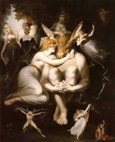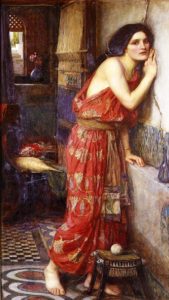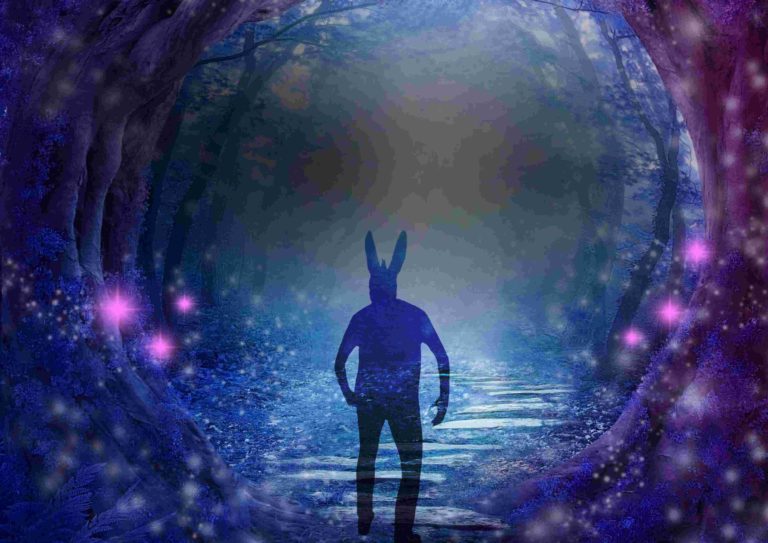BOB DYLAN’S SOON AFTER MIDNIGHT
THESEUS. Now, fair Hippolyta, our nuptial hour
Draws on apace; four happy days bring in
Another moon; but, O, methinks, how slow
This old moon wanes! She lingers my desires,
Like to a step-dame or a dowager,
Long withering out a young man’s revenue.
HIPPOLYTA. Four days will quickly steep themselves in night;
Four nights will quickly dream away the time;
And then the moon, like to a silver bow
New-bent in heaven, shall behold the night
Of our solemnities.
A Midsummer Night’s Dream Act 1, Sc. 1
It’s soon after midnight
And I’ve got a date with the fairy queen…

With the deceptively gentle Soon After Midnight we are still being ‘softened up’ for the carnage that will follow. The song is addressed to an ambiguous love object, a ghostly dream figure who seems to take on various different forms and appear and disappear at will. One of Poe’s heroines, perhaps… a character in ‘a dream within a dream’… Someone who will always be slightly out of the singer’s, and our, grasp. The song uses a melody that is based on a popular standard of the 1930s, The Moon Got In My Eyes, written by Johnny Burke (the lyricist of many popular tunes including Pennies From Heaven and Moonlight Becomes You) and composer Arthur Johnston. The song was made famous by Bing Crosby, and Frank Sinatra later recorded a memorable version with Nelson Riddle’s orchestration. The sentiments are a conventional portrayal of the disillusioned lover who tells us that …I thought a kingdom was in sight /That I would have the right to claim /But with the morning’s early light/ I didn’t have a dream to my name… The refrain complains that …I guess I should have seen right through you/ But the moon got in my eyes… Dylan adapts this melody, and retains some of the song’s mournful and regretful tone. He toys with romantic clichés throughout, but also expresses a few dark and murderous hints that serve to prepare us for the songs of apocalyptic rage that are to follow. Yet Soon After Midnight is also imbued with mystery and magic. If this is a love song, it seems to be directed not at a real person but at a mythical spirit who the singer seems intent on surrendering himself to, at whatever cost.

As the train fades into the distance, drums and guitars kick into a slow, languid rhythm. Dylan’s voice, when it comes in after a few seconds, is dreamy, detached, almost a whisper. The language of the song is precise and compressed, the enunciation of every word clear and distinct. There is certainly no ‘Louis Armstrong’ rasp here. The singer pronounces the words sweetly and lovingly. As he delivers the first rhyme he rolls the words around his tongue, adopting the traditional posture of the humbled lover: …I’m searching for phrases/To sing your praises… Already there is a slight suggestion of irony. The singer sounds almost apologetic, as if he is already lapsing into cliché because the emotions he feels are rendering him almost speechless. Maybe he’s down on his knees, begging to be heard, confessing his own inadequacies: …I need to tell someone… he breathes. Then he begins to draw us inexorably into the world of his own imagination: ..It’s soon after midnight/And my day has just begun… We are entering a kind of half-conscious, half-dream state. As if to lull us into submission, Dylan entices us with this lovely melody into a dreamscape in which we can never quite tell the difference between poetic fantasy and harsh reality. Having played the penitent lover, he now he begins to explain how he has been wronged: …A girl named Honey/Took my money/ She was passing by … The ‘money/honey’ rhyme again flirts ironically with cliché, and itself refers to the 1950s standard about a ‘gold digging’ woman Money Honey, written by Jesse Stone and recorded by The Drifters, Little Richard, Elvis Presley and many others. But the line ‘she was passing by’, and the singer’s apparent detachment, as conveyed by the smooth vocal, suggests that the girl is a mere passing shadow, a ghostly figure or an illusion. The way Dylan draws out his delivery of ‘passing’ adds to this effect, which is further emphasised by … It’s soon after midnight/And the moon is in my eye… Here, the central image of The Moon Got In My Eye is retained; the idea being that the singer has been ‘blinded’ by the girl’s luminescent beauty. Dylan’s adaptation of the line, however, adds another dimension to the words. ‘The moon is in my eye’ suggests a hint of madness but also a kind of reflectiveness. So we are drawn further into the narrator’s consciousness. We see our own reflection in the narrator’s eyes. This is the key moment of transformation in the song. Now the narrator’s attitude changes from one of supplication to one of defiance. The calm, dreamy tone begins give way to an ominous one. In the third verse, Dylan begins with …My heart is cheerful/It’s never fearful/I’ve been down on the killing floors… The cheerful/fearful rhyme, like the earlier phrases/praises and money/honey sounds slightly ‘forced’, which gives the singer’s protestations an edge of tension, as if he isn’t really sure of what he’s saying and is really trying to convince himself of the veracity of his statements. The conjunction of the words used adds to this effect. The first line echoes the Biblical proverb …A cheerful heart is good medicine, but a crushed spirit dries up the bones (Proverbs 17:22, New International Bible). However, the reference to ‘killing floors’ is weirdly jarring, juxtaposing harsh blues imagery against dreamy romantic cliché. The expression features in the Howlin’ Wolf song Killing Floor (1964)(which was frequently covered by Jimi Hendrix and Led Zeppelin) and the much earlier Skip James song Hard Time Killing Floor Blues (circa 1931). The term literally refers to the slaughterhouses in which many black workers were employed when they arrived in Chicago after migrating from the Deep South in the 1920s and 30s. The term was used in the blues as a metaphor for a hopeless situation, especially in a sexual relationship. The singer seems to be implying that he has been through so much pain in his love life that he has learned that he may as well always be ‘cheerful’. However, we may by now begin to suspect that he is merely trying to reassure himself. The next lines …I’m in no great hurry/ I’m not afraid of your fury/ I’ve faced stronger walls than yours… again show him struggling with an awkward rhyme, although Dylan (always the master of phrasing ‘weird’ rhymes) delivers ‘hurry’ and ‘fury’ without a moment’s embarrassment. As he pronounces the final lines here he seems to be gathering his own courage for some conflict to come. But suddenly we seem to be a rather different ‘ballpark’. The ‘girl’ that the song is addressed to seems to have placed a ‘wall’ up against him, which the singer seems determined to negotiate. The strange image of a lover’s ‘wall’ can be found in tragic story of the archetypal doomed lovers Pyramus and Thisbe, whose tale was related by Ovid in his Metamorphoses. In this story, the lovers are told by their warring families that they are not allowed to see each other and the only way they can communicate is through a crack in the wall that adjoins their houses. The two lovers later both commit suicide in a confused situation that Shakespeare adapted for the tragic ending of Romeo And Juliet. Shakespeare also mercilessly satirised Ovid’s story for considerable comic effect in the ‘play within as play’ in A Midsummer Night’s Dream. And as the next verse will verify, Soon After Midnight itself describes a kind of Midsummer Night’s Dream, a scenario in which the illusions of love are made manifest.

Now we are presented with more rather oddly juxtaposed references: …Charlotte the Harlot/Dresses in scarlet/ Mary dresses in green…. Here, the woman the song is addressed to appears to be being compared, in a rather self consciously obvious way, to opposing female archetypes. The harlot/scarlet rhyme (which is pronounced with delicious irony) depicts a prostitute or ‘scarlet woman’ while ‘Mary’ is a name connoting innocence (as in the mother of our Lord in Duquesne Whistle). Then, in the song’s most delicious line, Dylan croons …it’s soon after midnight/And I’ve got a date with the fairy queen…. He sounds very pleased with himself, as he steps out of the mundane and into the magical world. The allusion to A Midsummer Night’s Dream seems fairly explicit here. The implication seems to be that the object of the singer’s affection, his ‘Titania’, is a far greater ‘catch’ than any of the other women in the song and that his love for her is magically transcendent. This mood of defiance continues in the next verse, in which the singer defies the rest of the world, those who …chirp and they chatter… shrugging this off with an apparently nonchalant … What does it matter?… But suddenly the imagery turns mysteriously violent. Those who are opposed to the romance of this modern Pyramus and Thisbe (or Romeo and Juliet) are said to be…lying and dying in their blood… And the narrator suddenly refers to ‘two timing Slim’, another rather jarring shift (possibly a reference to ‘bad motherfucker’ anti-hero of a Johnny Otis song) and declares he will … drag his corpse through the mud… It seems that he will be giving his enemies no quarter despite engaging in this ‘forbidden love’. And yet he still sounds serenely self confident. In the final verse the singer seems to take a deep breath before finding the courage to step out with his ‘fairy queen’. The sly juxtaposition of the title of the famous Elvis song It’s Now or Never with the shy but determined …more than ever… again emphasizes the playful, intimate nature of the address. The ironic use of the vernacular … When I met you/ I didn’t think you’d do… is charmingly counter posed against the final, rather touching, protestation of true love: …I don’t want nobody but you…
Soon After Midnight is a subtle song of defiance, a ‘mystical love song’ that can also be seen as a testament to the artist’s devotion to his craft. While in Duquesne Whistle the singer seems to need to summon considerable energy to profess his continuing vitality, here he conveys it with a sly nod and a wink and a knowing twinkle in his eye. There is a sense that the love he is conveying is somehow forbidden, and the song jolts into weird occasional flashes of anger against those who would prevent this consummation. Again Dylan can be seen, on one level, as addressing his audience, inviting them into a pact or a ‘midnight tryst’ so that together they can plunge into the recesses of the symbolic world full of strange metamorphoses that will inhabit the rest of the album. Soon we will meet those who indeed ‘lie in their own blood’. This will be less a midsummer night’s dream than a kind of nightmare. But here is Dylan as Prospero again, weaving his magical spell, crooning smoothly through this beautiful song. The moon is in his eyes. It is past midnight. Take a deep breath… He will soon be leading us by the hand, into the darkness.

A different version of this text appears in DETERMINED TO STAND: THE REINVENTION OF BOB DYLAN
DYLAN LINKS
DAILY DYLAN NEWS at the wonderful EXPECTING RAIN
THE BOB DYLAN PROJECT- COMPREHENSIVE LISTINGS
STILL ON THE ROAD – ALL DYLAN’S GIGS
THE CAMBRIDGE BOB DYLAN SOCIETY



Leave a Reply